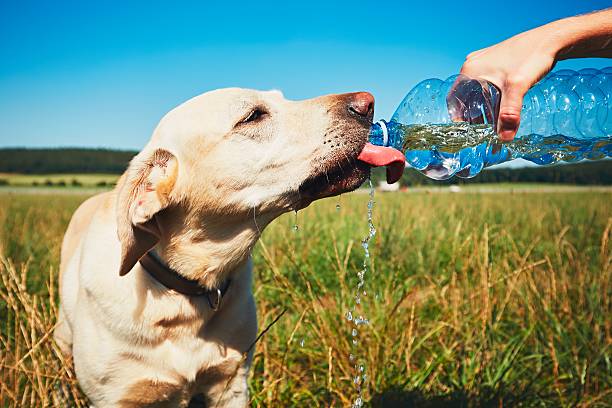If you’re a dog owner, you know dogs have energy to burn. And taking them for a walk is one of the best ways to provide your furry friend with the physical and mental stimulation they need. As with people, moving their bodies helps them feel their best, maintain muscle tone, and keep their weight where it needs to be for their age and breed.
But despite the health benefits of taking Fido for a walk or letting him play for hours on end, there are some things to be on the lookout for when you are out for that leisurely stroll or even playing fetch in the backyard—signs your dog might be dehydrated.
Is Your Dog Panting—A Lot? He May Be Dehydrated
As responsible pet owners, we want the best for our furry companions. But have you ever wondered why your dog is panting excessively, even on a cool day? It turns out that this common behavior could be more than just a case of being warm—it might be a telltale sign that your beloved pup needs hydration. In this article, we’ll explore nine subtle and not-so-subtle signs that your dog might be dehydrated and provide valuable insights on how to keep them happy, healthy, and properly hydrated.
Since severe fluid shortage can lead to the failure of the kidneys and other organs in your beloved pet, it’s critical to know the warning signs.
- Loss of skin elasticity, where the skin doesn’t quickly return to its original position when gently pulled, can indicate dehydration in your dog.
- A decreased appetite or refusal to eat may indicate that your dog is dehydrated.
- Vomiting, with or without diarrhea, can be a symptom of dehydration in dogs.
- If your dog appears less energetic, seems lethargic, or shows a lack of interest in activities, it could result from dehydration.
- Excessive panting, especially in cooler temperatures, indicates your dog needs water access.
- Sunken and dry-looking eyes can mean that your dog needs more fluids.
- A dry nose, in contrast to a moist nose, can be a sign of dehydration in dogs.
- Dry and sticky gums, rather than moist and slick gums, can be a symptom of dehydration.
- If your dog’s saliva appears thick or sticky, it may indicate dehydration.
The Dangers of Doggy Dehydration & What To Do About It
Dehydration in dogs poses serious risks to their health and well-being. It can impact vital functions such as circulation, joint lubrication, digestion, and organ function. Dogs may experience decreased blood flow without proper hydration, leading to organ damage and even failure.
Further, dehydration can impair a dog’s thermoregulation, making them more susceptible to heatstroke, a potentially life-threatening condition. A lack of water can lead to constipation and urinary tract issues if that isn’t bad enough. So if your dog shows signs of dehydration, it’s critical to address it right away.
What to Do If Your Dog is Mildly Dehydrated
If your dog is showing any of the dehydration symptoms we mentioned above, you can remedy the situation by offering them small amounts of water. Sit with your dog to offer comfort while they drink, but try to keep them from drinking too much all at once (this can lead to vomiting). Once the panting or other warning symptoms begin to subside, be sure to fill their water dish and let your dog have access to water as normal.
Remember that water is vital for properly functioning a dog’s body, as it constitutes a major component of healthy living cells. When dogs don’t receive an adequate water supply, they can become dehydrated, negatively impacting their overall well-being. To ensure your dog stays hydrated, it’s essential to clean and refill their water bowl daily, providing them with access to fresh water at all times.
What to Do If Your Dog is Severely Dehydrated
As we mentioned earlier, life-threatening consequences can arise from severe dehydration as it impairs vital organs like the heart, liver, and kidneys. This diminished cardiac output and compromised blood circulation throughout the body can result in organ failure and shutdown.
Recognizing the symptoms and warning signs of doggy dehydration can help safeguard their health. However, if your dog is lethargic, has decreased or increased urination, diarrhea, vomiting, or has not eaten in 24 hours, contact your vet immediately. Call a vet hospital or bring your pup to the ER vet immediately if it is outside your vet clinic’s hours.
Ensure Your Pup Has Access to Water at All Times
Ensuring your dog has access to water at all times is super important for their overall health and well-being. Whether indoors or engaging in outdoor activities like playing or going for a walk, providing them with a constant water source is vital.
Visit your nearest Pet Evolution store for new water bowls or travel-friendly tri-fold water containers perfect for summer, enabling your beloved companion, Fido, to stay hydrated even while on the go. Remember, keeping them properly hydrated is a simple yet essential step towards ensuring their happiness and vitality.
